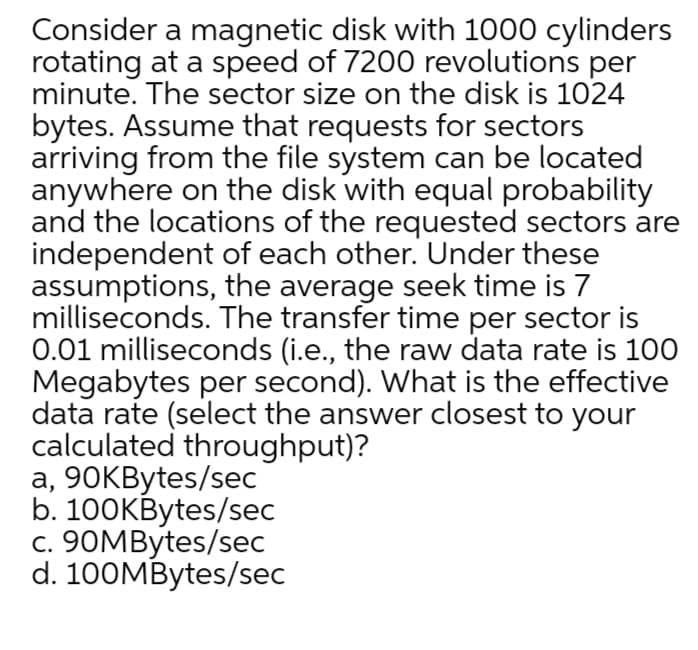Consider a magnetic disk with 1000 cylinders rotating at a speed of 7200 revolutions per minute. The sector size on the disk is 1024 bytes. Assume that requests for sectors arriving from the file system can be located anywhere on the disk with equal probability and the locations of the requested sectors are independent of each other. Under these assumptions, the average seek time is 7 milliseconds The transfer time per sector is
Consider a magnetic disk with 1000 cylinders rotating at a speed of 7200 revolutions per minute. The sector size on the disk is 1024 bytes. Assume that requests for sectors arriving from the file system can be located anywhere on the disk with equal probability and the locations of the requested sectors are independent of each other. Under these assumptions, the average seek time is 7 milliseconds The transfer time per sector is
Computer Networking: A Top-Down Approach (7th Edition)
7th Edition
ISBN:9780133594140
Author:James Kurose, Keith Ross
Publisher:James Kurose, Keith Ross
Chapter1: Computer Networks And The Internet
Section: Chapter Questions
Problem R1RQ: What is the difference between a host and an end system? List several different types of end...
Related questions
Question

Transcribed Image Text:Consider a magnetic disk with 1000 cylinders
rotating at a speed of 7200 revolutions per
minute. The sector size on the disk is 1024
bytes. Assume that requests for sectors
arriving from the file system can be located
anywhere on the disk with equal probability
and the locations of the requested sectors are
independent of each other. Under these
assumptions, the average seek time is 7
milliseconds. The transfer time per sector is
0.01 milliseconds (i.e., the raw data rate is 100
Megabytes per second). What is the effective
data rate (select the answer closest to your
calculated throughput)?
a, 90KBytes/sec
b. 100KBytes/sec
c. 90MBytes/sec
d. 100MBytes/sec
Expert Solution
This question has been solved!
Explore an expertly crafted, step-by-step solution for a thorough understanding of key concepts.
This is a popular solution!
Trending now
This is a popular solution!
Step by step
Solved in 2 steps

Recommended textbooks for you

Computer Networking: A Top-Down Approach (7th Edi…
Computer Engineering
ISBN:
9780133594140
Author:
James Kurose, Keith Ross
Publisher:
PEARSON

Computer Organization and Design MIPS Edition, Fi…
Computer Engineering
ISBN:
9780124077263
Author:
David A. Patterson, John L. Hennessy
Publisher:
Elsevier Science

Network+ Guide to Networks (MindTap Course List)
Computer Engineering
ISBN:
9781337569330
Author:
Jill West, Tamara Dean, Jean Andrews
Publisher:
Cengage Learning

Computer Networking: A Top-Down Approach (7th Edi…
Computer Engineering
ISBN:
9780133594140
Author:
James Kurose, Keith Ross
Publisher:
PEARSON

Computer Organization and Design MIPS Edition, Fi…
Computer Engineering
ISBN:
9780124077263
Author:
David A. Patterson, John L. Hennessy
Publisher:
Elsevier Science

Network+ Guide to Networks (MindTap Course List)
Computer Engineering
ISBN:
9781337569330
Author:
Jill West, Tamara Dean, Jean Andrews
Publisher:
Cengage Learning

Concepts of Database Management
Computer Engineering
ISBN:
9781337093422
Author:
Joy L. Starks, Philip J. Pratt, Mary Z. Last
Publisher:
Cengage Learning

Prelude to Programming
Computer Engineering
ISBN:
9780133750423
Author:
VENIT, Stewart
Publisher:
Pearson Education

Sc Business Data Communications and Networking, T…
Computer Engineering
ISBN:
9781119368830
Author:
FITZGERALD
Publisher:
WILEY